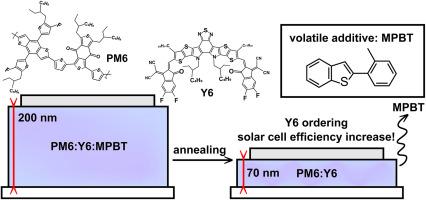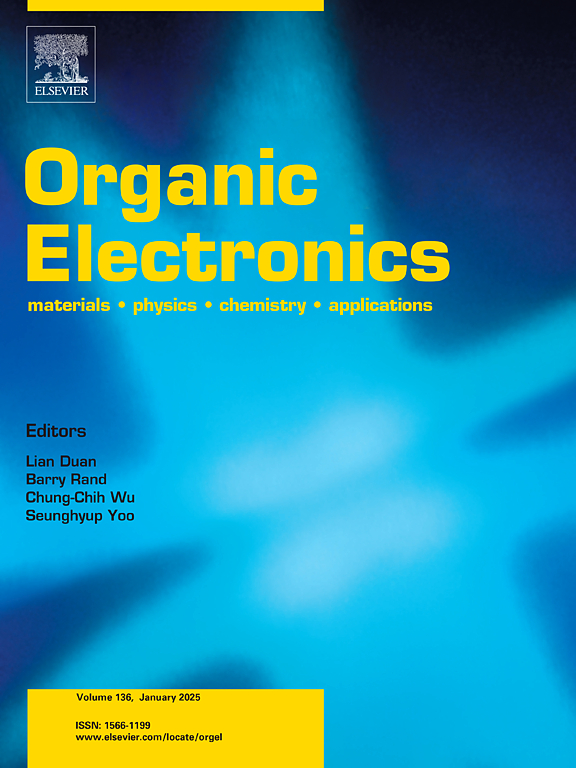Volatile additive for selective tuning of non-fullerene acceptor morphology in the active layer of organic solar cells
IF 2.6
4区 工程技术
Q3 MATERIALS SCIENCE, MULTIDISCIPLINARY
引用次数: 0
Abstract
2-(2-Methylphenyl)benzo[b]thiophene (MPBT) is synthesized and applied as volatile additive to PM6/Y6 active layer of organic solar cells, where PM6 is donor polymer, Y6 is non-fullerene acceptor. Contrary to usual solvent additives, MPBT is not removed from the active layer during spin-coating. However, due to volatility of MPBT, annealing at 120 °C allows for its complete removal from PM6/Y6 composite. Moreover, its morphology is markedly altered by MPBT, as it is evidenced by optical spectroscopy and atomic force microscopy. For a thin PM6/Y6 active layer (about 70 nm) cast from chlorobenzene, the optimal concentration of MPBT is 5 wt %, relative to the solvent. Use of this additive leads to improvement of short circuit current JSC and fill factor (FF), and consequently, to power conversion efficiency (PCE) increase. External quantum efficiency (EQE) is improved within the whole range of PM6:Y6 optical absorption (350–850 nm). Optical, X-ray diffraction, and atomic-force microscopy data confirm ordering of Y6 domains during MPBT volatilization, while morphology of PM6 domains is almost not altered. Space-charge limited current measurement evidences that electron mobility increases several times upon volatilization of MPBT from PM6:Y6 film, while hole mobility remains essentially unchanged. Surface free energy measurement confirms preferential miscibility of MPBT with Y6 component of the active layer rather than with PM6 component. Storage and operational stability of the solar cells processed with MPBT markedly increase. GIWAXS pattern of pristine Y6 film processed with MPBT show unusually high orientation ordering of Y6 crystallines with respect to the substrate. The novel approach based on intermediate donor:acceptor:additive ternary blend gives additional degree of control of active layer properties by selective tuning of the acceptor morphology.

有机太阳能电池活性层中选择性调节非富勒烯受体形态的挥发性添加剂
合成了2-(2-甲基苯基)苯并[b]噻吩(MPBT),并将其作为挥发性添加剂应用于有机太阳能电池PM6/Y6活性层,其中PM6为给体聚合物,Y6为非富勒烯受体。与通常的溶剂添加剂相反,MPBT在旋转涂层过程中不会从活性层中去除。然而,由于MPBT的挥发性,在120°C下退火可以使其完全从PM6/Y6复合材料中去除。此外,光谱学和原子力显微镜也证实了MPBT对其形貌的显著改变。对于由氯苯铸造的薄PM6/Y6活性层(约70 nm),相对于溶剂,MPBT的最佳浓度为5 wt %。使用该添加剂可以改善短路电流JSC和填充因子(FF),从而提高功率转换效率(PCE)。外量子效率(EQE)在PM6:Y6光吸收的整个范围内(350 ~ 850 nm)均有提高。光学,x射线衍射和原子力显微镜数据证实了在MPBT挥发过程中Y6结构域的有序,而PM6结构域的形态几乎没有改变。空间电荷限制电流测量表明,在PM6:Y6薄膜中挥发MPBT后,电子迁移率增加了数倍,而空穴迁移率基本保持不变。表面自由能测定证实MPBT与活性层Y6组分的混相优于与PM6组分的混相。经MPBT处理后的太阳能电池储能性能和运行稳定性明显提高。用MPBT处理的原始Y6薄膜的GIWAXS模式显示Y6晶体相对于衬底的取向有序度异常高。这种基于中间供体-受体-添加剂三元共混的新方法通过选择性调整受体形态来控制活性层的性质。
本文章由计算机程序翻译,如有差异,请以英文原文为准。
求助全文
约1分钟内获得全文
求助全文
来源期刊

Organic Electronics
工程技术-材料科学:综合
CiteScore
6.60
自引率
6.20%
发文量
238
审稿时长
44 days
期刊介绍:
Organic Electronics is a journal whose primary interdisciplinary focus is on materials and phenomena related to organic devices such as light emitting diodes, thin film transistors, photovoltaic cells, sensors, memories, etc.
Papers suitable for publication in this journal cover such topics as photoconductive and electronic properties of organic materials, thin film structures and characterization in the context of organic devices, charge and exciton transport, organic electronic and optoelectronic devices.
 求助内容:
求助内容: 应助结果提醒方式:
应助结果提醒方式:


